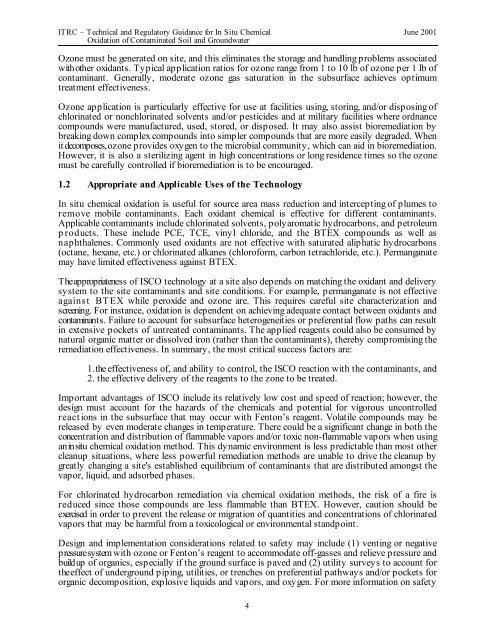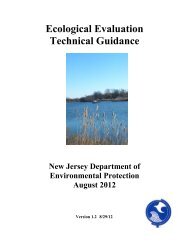Technical and Regulatory Guidance for In Situ Chemical ... - ITRC
Technical and Regulatory Guidance for In Situ Chemical ... - ITRC
Technical and Regulatory Guidance for In Situ Chemical ... - ITRC
You also want an ePaper? Increase the reach of your titles
YUMPU automatically turns print PDFs into web optimized ePapers that Google loves.
<strong>ITRC</strong> – <strong>Technical</strong> <strong>and</strong> <strong>Regulatory</strong> <strong>Guidance</strong> <strong>for</strong> <strong>In</strong> <strong>Situ</strong> <strong>Chemical</strong> June 2001<br />
Oxidation of Contaminated Soil <strong>and</strong> Groundwater<br />
Ozone must be generated on site, <strong>and</strong> this eliminates the storage <strong>and</strong> h<strong>and</strong>ling problems associated<br />
with other oxidants. Typical application ratios <strong>for</strong> ozone range from 1 to 10 lb of ozone per 1 lb of<br />
contaminant. Generally, moderate ozone gas saturation in the subsurface achieves optimum<br />
treatment effectiveness.<br />
Ozone application is particularly effective <strong>for</strong> use at facilities using, storing, <strong>and</strong>/or disposing of<br />
chlorinated or nonchlorinated solvents <strong>and</strong>/or pesticides <strong>and</strong> at military facilities where ordnance<br />
compounds were manufactured, used, stored, or disposed. It may also assist bioremediation by<br />
breaking down complex compounds into simpler compounds that are more easily degraded. When<br />
it decomposes, ozone provides oxygen to the microbial community, which can aid in bioremediation.<br />
However, it is also a sterilizing agent in high concentrations or long residence times so the ozone<br />
must be carefully controlled if bioremediation is to be encouraged.<br />
1.2 Appropriate <strong>and</strong> Applicable Uses of the Technology<br />
<strong>In</strong> situ chemical oxidation is useful <strong>for</strong> source area mass reduction <strong>and</strong> intercepting of plumes to<br />
remove mobile contaminants. Each oxidant chemical is effective <strong>for</strong> different contaminants.<br />
Applicable contaminants include chlorinated solvents, polyaromatic hydrocarbons, <strong>and</strong> petroleum<br />
p roducts. These include PCE, TCE, vinyl chloride, <strong>and</strong> the BTEX compounds as well as<br />
naphthalenes. Commonly used oxidants are not effective with saturated aliphatic hydrocarbons<br />
(octane, hexane, etc.) or chlorinated alkanes (chloro<strong>for</strong>m, carbon tetrachloride, etc.). Permanganate<br />
may have limited effectiveness against BTEX.<br />
The appropriateness of ISCO technology at a site also depends on matching the oxidant <strong>and</strong> delivery<br />
system to the site contaminants <strong>and</strong> site conditions. For example, permanganate is not effective<br />
against BT EX while peroxide <strong>and</strong> ozone are. This requires careful site characterization <strong>and</strong><br />
screening. For instance, oxidation is dependent on achieving adequate contact between oxidants <strong>and</strong><br />
contaminants. Failure to account <strong>for</strong> subsurface heterogeneities or preferential flow paths can result<br />
in extensive pockets of untreated contaminants. The applied reagents could also be consumed by<br />
natural organic matter or dissolved iron (rather than the contaminants), thereby compromising the<br />
remediation effectiveness. <strong>In</strong> summary, the most critical success factors are:<br />
1. the effectiveness of, <strong>and</strong> ability to control, the ISCO reaction with the contaminants, <strong>and</strong><br />
2. the effective delivery of the reagents to the zone to be treated.<br />
Important advantages of ISCO include its relatively low cost <strong>and</strong> speed of reaction; however, the<br />
design must account <strong>for</strong> the hazards of the chemicals <strong>and</strong> potential <strong>for</strong> vigorous uncontrolled<br />
reactions in the subsurface that may occur with Fenton’s reagent. Volatile compounds may be<br />
released by even moderate changes in temperature. There could be a significant change in both the<br />
concentration <strong>and</strong> distribution of flammable vapors <strong>and</strong>/or toxic non-flammable vapors when using<br />
an in situ chemical oxidation method. This dynamic environment is less predictable than most other<br />
cleanup situations, where less powerful remediation methods are unable to drive the cleanup by<br />
greatly changing a site's established equilibrium of contaminants that are distributed amongst the<br />
vapor, liquid, <strong>and</strong> adsorbed phases.<br />
For chlorinated hydrocarbon remediation via chemical oxidation methods, the risk of a fire is<br />
reduced since those compounds are less flammable than BTEX. However, caution should be<br />
exercised in order to prevent the release or migration of quantities <strong>and</strong> concentrations of chlorinated<br />
vapors that may be harmful from a toxicological or environmental st<strong>and</strong>point.<br />
Design <strong>and</strong> implementation considerations related to safety may include (1) venting or negative<br />
pressure system with ozone or Fenton’s reagent to accommodate off-gasses <strong>and</strong> relieve pressure <strong>and</strong><br />
build up of organics, especially if the ground surface is paved <strong>and</strong> (2) utility surveys to account <strong>for</strong><br />
the effect of underground piping, utilities, or trenches on preferential pathways <strong>and</strong>/or pockets <strong>for</strong><br />
organic decomposition, explosive liquids <strong>and</strong> vapors, <strong>and</strong> oxygen. For more in<strong>for</strong>mation on safety<br />
4
















